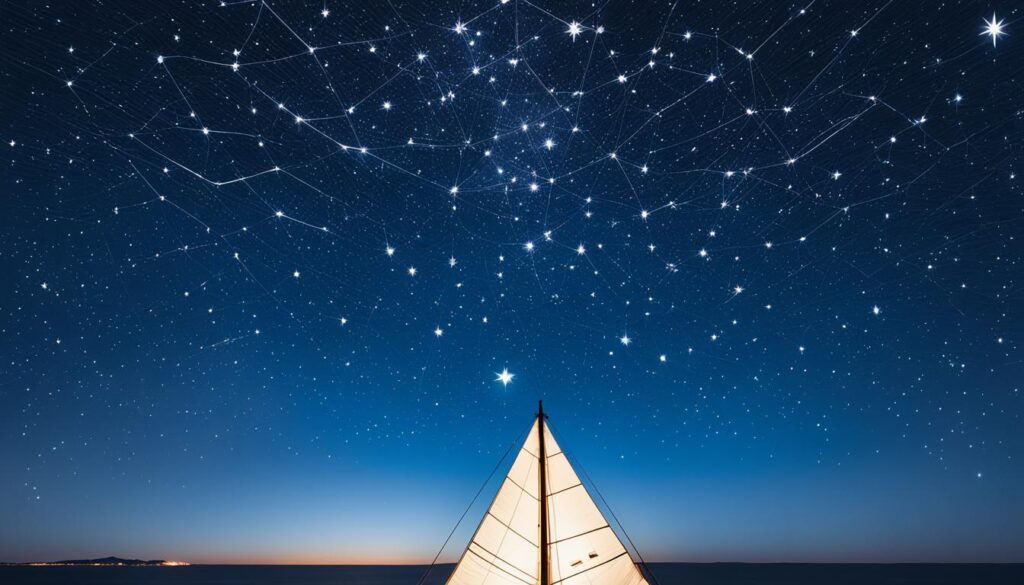Welcome to the celestial marvels of the southern sky, where you’re invited to explore the intriguing diamond cross asterism. Unlike common gemstone patterns or religious symbols, this diamond cross embodies a stellar spectacle that has captured the imagination of astronomers and stargazers alike. As you embark on this journey, you’ll unravel the diamond cross asterism meaning and delve into the mystique of this natural diamond cross asterism. With origins steeped in ancient lore and positioned in the constellation Carina, the asterism is a unique blend of history and science amidst the stars. Let’s illuminate the sky and discern the starry diamond that adorns our cosmic canvas.
Key Takeaways
- Discover the diamond cross asterism, a celestial pattern distinguished from common jewelry designs or gemstone cuts.
- Understand that the diamond cross asterism meaning lies in its kite-like shape made by stars Miaplacidus, Theta Carinae, Upsilon Carinae, and Omega Carinae.
- Learn about the asterism’s role amid the southern sky’s constellations and its historical significance in celestial storytelling.
- Gain insight into why this natural diamond cross asterism is a gem of the southern hemisphere, available only to certain latitudes.
- Appreciate the diamond cross asterism’s distinction from other southern asterisms like the Southern Cross and the False Cross.
- Identify the stars that make up this unique asterism and reflect on their individual contributions to its overall allure.
Understanding the Diamond Cross Asterism
If you’re drawn to the stars, you may have heard of the diamond cross asterism, a captivating formation that graces the skies. This dazzling configuration is not only a wonder to behold but also rich in history and astronomy.
Origins and Location in the Night Sky
The diamond cross asterism formation has its roots in the vast expanse of the constellation Carina. This stellar nursery, known as the keel of the mythological ship Argo Navis, was divided into three distinct constellations, with Carina being one of them. The diamond cross is not just a random occurrence but an integral part of this storied constellation.
Key Stars Forming the Asterism
A quartet of luminous stars, each with its own tale, give life to the diamond cross asterism. Miaplacidus, Theta Carinae, Upsilon Carinae, and Omega Carinae fuse together to craft the asterism’s iconic shape. These diamond cross asterism stars range in type from youthful A- and B-type stars, such as Theta Carinae, known for being a blue straggler, to Omega Carinae, noted for its Be star classification and surrounding circumstellar material.
| Star Name | Type | Magnitude | Remarkable Feature |
|---|---|---|---|
| Miaplacidus (Beta Carinae) | A-type Giant | 1.68 | 2nd brightest in Carina |
| Theta Carinae | B-type Blue Straggler | 2.76 | Part of IC 2602 cluster |
| Upsilon Carinae | A-type Giant | 3.01 | Variable luminosity |
| Omega Carinae | Be Star | 3.32 | Displays circumstellar material |
Misidentification with Other Southern Crosses
Despite its unique beauty, the diamond cross asterism phenomena sometimes play a trick on the eyes, leading to confusion with the Southern Cross and the False Cross. Distinguishing this asterism from its celestial neighbors is crucial, especially for those relying on the stars for navigation. Notably, the Southern Cross is closer to the stars Rigil Kentaurus and Hadar, whereas the diamond cross nestles between the Southern Pointers and Canopus.
As you explore the night sky from the southern hemisphere, keep an eye out for these diamond cross asterism examples, and you’ll be well on your way to unraveling the mysteries of the stars above us.
Formation and Characteristics of Diamond Cross Asterism Stars
The distinctive diamond cross asterism formation captures the imagination of those who gaze skyward, offering a visual spectacle that highlights the splendor of the cosmos. Far from being a family of nearby celestial bodies, the asterism’s stars are scattered across vast interstellar distances. It is their brightness and relative position from our point of view on Earth that weaves the tapestry of this celestial diamond.

At the heart of the Diamond Cross lies Miaplacidus, a beacon in the night sky, whose white giant stature provides significant luminosity to anchor the asterism’s shape. It spins with a velocity that adds to its brilliance, making it a prominent feature for stargazers. Following Miaplacidus is Omega Carinae, a blue giant whose hot surface contributes a stark contrast to the cooler stars around it, enriching the asterism’s types and spectrum.
The Diamond Cross is also home to Theta Carinae and Upsilon Carinae, younger A- and B-type stars that, despite their greater distance from us, shine with a light that cannot go unnoticed. Their luminous contribution to the asterism is as crucial as their more proximal counterparts, providing a balance and symmetry to the formation that both casual observers and astronomers find intriguing.
| Star Name | Type | Luminosity | Velocity | Distance from Earth (light-years) |
|---|---|---|---|---|
| Miaplacidus (Beta Carinae) | White Giant | High | Fast-spinning | ~113.2 |
| Omega Carinae | Blue Giant | Intense | Hot surface | ~1,400 |
| Theta Carinae | A-type | Bright | Moderate velocity | Variable |
| Upsilon Carinae | B-type | Bright | Moderate velocity | Variable |
The intricate dance of these stars, from the younger A- and B-type stars to the ancient white and blue giants, compose an awe-inspiring celestial mosaic. As you peel back the layers of the Diamond Cross asterism, remember that each component star burnishes the sky with its unique characteristics, encouraging us to look beyond the asterism as merely a pattern, to see it as a dynamic formation of stellar diversity.
The Diamond Cross Asterism in Astronomy and Navigation
Skilled navigators and stargazers alike marvel at the celestial wonders of the night sky. Among these, the natural diamond cross asterism stands out as a mesmerizing configuration that has challenged and enthralled observers in the southern hemisphere. You’ll find that understanding this asterism is not just about gazing at glittering dots in the abyss; it’s a blend of astronomy, myth, and the fine art of celestial navigation.

Role in Celestial Navigation
Historically, the Southern Cross has been a beacon for navigators seeking guidance across the oceans. However, the nearby diamond cross asterism also serves as a key signpost, albeit less heralded. This star formation acts as a supplementary reference when celestial navigators chart their courses, demonstrating its importance in navigation despite it being overshadowed by the more celebrated asterisms.
Visual Differences Between Southern Cross and Diamond Cross
The similarities between the Southern Cross and the diamond cross asterism might puzzle the casual observer, but keen eyes will note several distinctions. The diamond cross asterism examples include the noticeably more extended, kite-like form, with Miaplacidus as its brightest star, compared to the compact and bright cruciform pattern of the Southern Cross. Recognizing these subtle nuances is crucial for astronomers and navigators to ensure accuracy in their celestial readings.
Visibility from Various Latitudes
If you’re located in the northern hemisphere and wish to behold the diamond cross asterism, you might be out of luck. This stellar grouping is a jewel primarily in the southern sky’s crown, observable in its full splendor from latitudes below 20° N. This prevalent southern hemisphere observation makes it an exclusive spectacle for southern-based enthusiasts, cementing its status as a cherished part of the celestial canvas.
Exploring Deep Sky Objects Around the Diamond Cross Asterism
As you gaze at the night sky, within the bounds of the Carina constellation, a tapestry of celestial marvels unfolds around the Diamond Cross asterism. These deep sky objects, comprising both luminous clusters and mysterious nebulae, offer a visual feast for avid stargazers and professional astronomers alike. Below you’ll uncover the grandeur of the cosmos nestled near this southern asterism, and learn how observing deep sky objects can enrich your astronomical experience.
The Theta Carinae Cluster: A Cosmic Diamond
The illustrious Theta Carinae Cluster, also known as the Southern Pleiades, crowns the constellation with its brilliant blue stars. Similar to its northern namesake, it provides an impressive view, even without the aid of a telescope. This cluster not only enhances the Diamond Cross asterism’s appeal but also stands as a beacon, signifying the rich array of gemstones scattered across the Carina constellation.
Globular Clusters and Nebulae Near the Diamond Cross
Encircling the Diamond Cross asterism are several deep sky objects that further magnify the region’s splendor. The massive NGC 2808, one of the most substantial globular clusters within the Milky Way, presents a densely packed sphere of ancient stars, holding whispers of the early universe. Nearby, the nebulae NGC 3603 and NGC 3576 display cosmic phenomena, with NGC 3603 cradling some of the heftiest stars ever discovered, and NGC 3576 showcasing shapes that tease the imagination. These celestial bodies, alongside the Diamond Cross asterism gemstones, form a celestial jewel box waiting to be admired.
How to Observe Deep Sky Objects in Carina
Embarking on a journey to observe the Carina constellation’s riches requires little more than a clear southern sky and a sense of curiosity. March is prime time for witnessing these sights, as Carina reaches its zenith in visibility. With the constellation’s circumpolar nature in the southern hemisphere, it’s perpetually present within the night sky, ready to unveil its secrets to those who seek them.
Even without a telescope, your naked eye can pick out the Carina Nebula’s brilliant glow against the celestial canvas. Among the deep sky objects, the NGC 3372 emission nebula stands out, a cradle for nascent stars, and is easily observed under the right conditions. Armed with this knowledge, you’re well-equipped to embark on a nocturnal treasure hunt for the most alluring sights the Diamond Cross asterism and its environs have to offer.
| Deep Sky Object | Type | Description | Constellation |
|---|---|---|---|
| Theta Carinae Cluster (Southern Pleiades) | Open Cluster | A brilliant cluster resembling its northern counterpart, easily visible to the naked eye. | Carina |
| NGC 2808 | Globular Cluster | One of the Milky Way’s heaviest globular clusters, filled with densely packed stars. | Carina |
| NGC 3603 | Starburst Nebula | Known for containing extremely massive stars and being a notable H II region. | Carina |
| NGC 3576 | Emission Nebula | Features an intriguing structure that draws comparisons to the Statue of Liberty. | Carina |
| NGC 3372 (Carina Nebula) | Emission Nebula | A sprawling, bright nebula hosting active star-forming regions within. | Carina |
Diamond Cross Asterism Gemstone Cuts and Jewelry Inspiration
The enchanting patterns of the night sky have long been a muse for artisans and jewelers, leading to the creation of **diamond cross asterism jewelry** that mirrors the celestial map’s magnificence. If you hold a fascination for the cosmos, you’ll find the diamond cuts and gemstone arrangements inspired by the Diamond Cross asterism both compelling and rich with story. The intricate kite-like design that the asterism presents has been artfully translated into gemstone cuts that offer a sophisticated nod to the beauty above us.
Master jewelers meticulously craft **diamond cross asterism gemstone cuts**, imbuing each facet with the precision that echoes the stars’ arrangement in the constellation Carina. These specialized cuts, often custom and made to order, ensure that the jewelry you wear is not just an accessory, but a piece of cosmic art. Whether set into pendants, rings, earrings, or brooches, the gemstones reflect the Diamond Cross’s alignment, radiating an astral splendor that is both rare and mesmerizing.
By incorporating diamond cross asterism gemstone cuts into fine jewelry, designers enable you to carry a fragment of the universe with you. Such pieces often become heirlooms, treasured not only for their material value but also for their celestial inspiration. As you explore the world of diamond cross asterism jewelry, remember that each piece holds a story of distant suns and the mysteries they hold, awaiting to be carried gracefully into your life.
FAQ
What is the Diamond Cross Asterism?
The Diamond Cross Asterism is a celestial pattern located in the southern sky within the constellation Carina. It is formed by four main stars—Miaplacidus, Theta Carinae, Upsilon Carinae, and Omega Carinae—creating a diamond or kite-like shape rather than a traditional cross, despite its name.
Where can the Diamond Cross Asterism be found in the night sky?
The Diamond Cross Asterism is a distinctive feature of the southern hemisphere’s sky, found in the constellation Carina. It is best observed from locations south of latitude 20° N and sits between the Southern Cross and the False Cross asterisms.
Which stars make up the Diamond Cross Asterism?
The asterism is composed of four primary stars: Miaplacidus (Beta Carinae), Theta Carinae, Upsilon Carinae, and Omega Carinae. Miaplacidus is the brightest star in the asterism and the second brightest in the Carina constellation.
Why is the Diamond Cross often confused with the Southern Cross?
Misidentification between the Diamond Cross and the Southern Cross occurs due to their similar shapes, proximity, and shared location in the southern sky. However, the Southern Cross is more conspicuous, with brighter stars and a tighter cross-like formation, compared to the subtle, diamond-shaped Diamond Cross Asterism.
What role does the Diamond Cross Asterism play in celestial navigation?
The Diamond Cross Asterism serves as a reference point in the southern sky for celestial navigation, although it is less prominent than the nearby Southern Cross, which has been traditionally used to locate the south celestial pole.
What are the visual differences between the Southern Cross and Diamond Cross Asterisms?
The Southern Cross displays a more compact, cross-like formation, including some of the brightest stars in the sky, while the Diamond Cross is more elongated and diamond-shaped with less brightness overall, with Miaplacidus being its most luminous star.
Can the Diamond Cross Asterism be seen from northern latitudes?
No, the Diamond Cross is primarily visible in the southern hemisphere and cannot be seen from northern latitudes above 20° N, which makes it special for southern observers but out of sight for those in the northern segment of the globe.
What are some notable deep sky objects located near the Diamond Cross Asterism?
Close to the Diamond Cross, stargazers can find the Theta Carinae Cluster (Southern Pleiades), significant globular clusters like NGC 2808, and remarkable nebulae such as NGC 3603, which contains some of the most massive known stars, and NGC 3576, noted for its unique shape.
How can I observe deep sky objects in the constellation Carina?
The best time for observing deep sky objects in Carina is during the month of March when the constellation is most visible. The Carina Nebula (NGC 3372) is a particularly bright object you can see with the unaided eye under clear conditions, and the constellation is circumpolar in the southern hemisphere, making it observable throughout the year at certain times.
How is the Diamond Cross Asterism used in gemstone cuts and jewelry design?
Jewelers draw inspiration from the Diamond Cross Asterism’s unique pattern to create diamond cuts and jewelry that emulate its kite-like shape. The cosmic motif influences various design elements, allowing wearers to carry a piece of celestial beauty with them in the form of intricate jewelry pieces.






